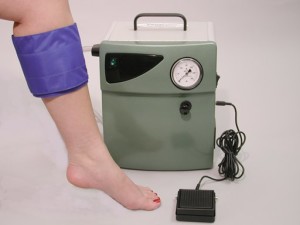The apparatus consist of Velcro cuffs with inbuilt air bags attached to a pneumatic pump by a long tube. The cuffs can be placed around the calf or foot depending on the venous segment under investigation. The inflation pressure is selected manually (usually 120 mmHg) and can be maintained until the deflation switch is activated which is usually 1-2 seconds later. Inflation and deflation is rapid, occurring in less than a second, and can be controlled from a foot pedal. Care must be taken to allow sufficient time for the veins to refill after an inflation/deflation otherwise there will not be enough blood available to eject. The advantage of using a pneumatic cuff over a manual calf compression/release manoeuvre is that the process can be easily controlled and the compression is independent of the size, position and strength of the examiners hand.
STAVROS KAKKOS The main benefit of pneumatic cuff compression is that it provides a standardised pressure to force antegrade venous flow with a quick release mechanism to induce reflux. This can all be achieved whilst the ultrasonographers hands remain free to operate the controls and hold the transducer. A study performed at the Henry Ford Hospital in Detroit, Michigan, USA has shown that for superficial veins the mean peak velocities of antegrade flow were similar between pneumatic and manual calf compression but the manual method had a significantly greater co-efficient of variation. Although the manual method was significantly better in achieving higher reflux velocities, both methods were comparable in the diagnosis of reflux. Future research may be helpful in deciding the place of the pneumatic cuff for training purposes as well as whether additional information can be obtained in the hands of a skilled ultrasonographer.
